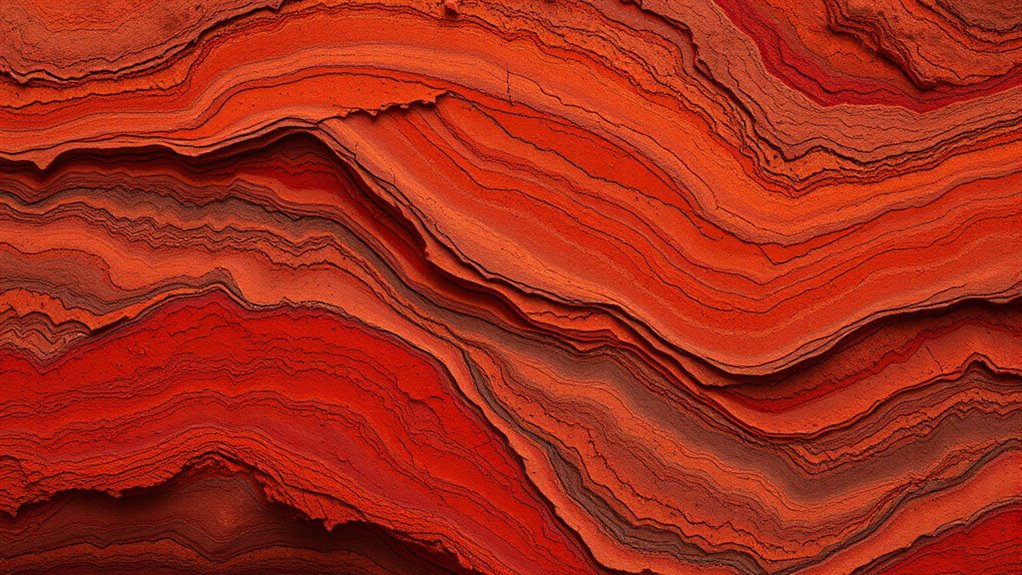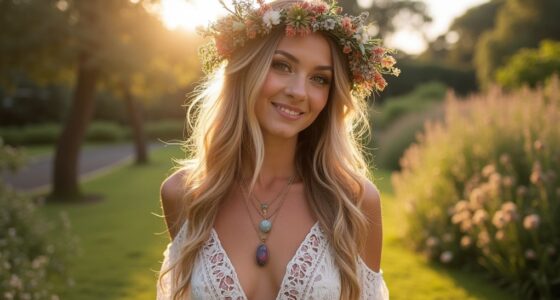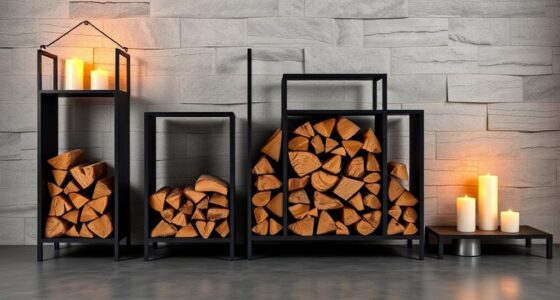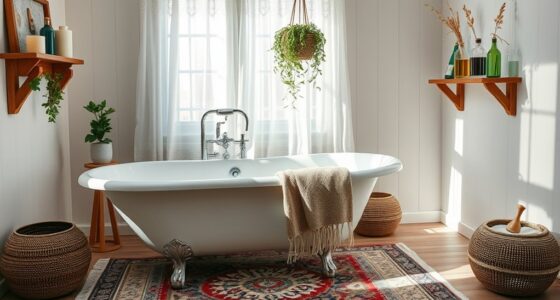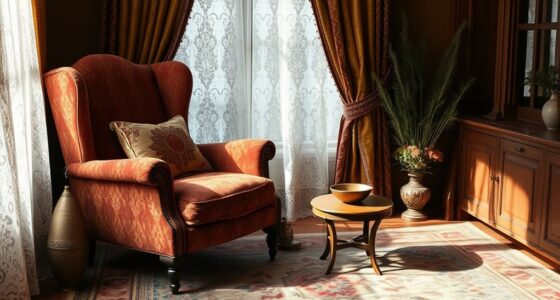Color-drenching in clay and ochre adds rich depth and dimension to your pre-fall wardrobe by layering thick, textured applications that highlight natural hues. Using techniques like blending, overlapping shades, and incorporating tactile materials amplifies the earthy tones, creating a grounded, sophisticated look. Fabrics like silk, linen, or wool enhance the richness of these colors. If you want to explore more about how these deep hues can elevate your style, keep going to discover inspiring ideas.
Key Takeaways
- Layer multiple coats of clay and ochre to build rich, dimensional color depth in pre-fall fashion pieces.
- Use blending techniques like wet-on-wet and gradual layering for seamless transitions and nuanced hues.
- Incorporate textured tools and natural elements such as sand or plant fibers to enhance tactile and visual richness.
- Choose fabrics like silk, satin, wool, or linen to amplify the vibrancy and depth of clay and ochre dyes.
- Emphasize earth-toned styling with layered garments and accessories for versatile, sustainable pre-fall looks.
The Appeal of Earthy Tones in Pre-Fall Fashion

Earthy tones have become a standout choice in pre-fall fashion, offering a natural and sophisticated appeal. You’ll notice how shades like clay, ochre, and taupe evoke a sense of grounded elegance, seamlessly blending with the changing season. You can enhance this effect by layering with complementary textures, which adds depth and visual interest to your outfits. Incorporating color harmony principles can help create cohesive and balanced looks that highlight these shades. These colors resonate with the desire for comfort and authenticity, making them versatile for both casual and polished looks. Their subdued yet rich hues add depth to your wardrobe, allowing you to layer effortlessly while maintaining a refined appearance. Earth tones also provide a timeless quality, ensuring your outfits remain stylish across seasons. Incorporating soil pH levels and proper soil management techniques can enhance the natural look of earthy tones in your wardrobe. When you incorporate these shades, you embrace a connection to nature, grounding your wardrobe in a color palette that’s both calming and effortlessly chic. Utilizing color-drenching techniques can help you achieve a more vibrant and cohesive look that accentuates these earthy shades.
Understanding Color-Drenching: Techniques and Textures

You can create rich, layered effects by experimenting with different layering techniques to add depth. Varying textures in your paints enhances tactile interest and visual complexity. Mastering color blending strategies allows you to seamlessly unify shades for a more immersive, drench-like finish. Incorporating security measures into your process can help protect your work from digital vulnerabilities and unauthorized access. Additionally, understanding relationships and communication dynamics can inspire more emotionally resonant color palettes and compositions. Recognizing breed traits can also inform your choice of colors and textures to better represent specific dog breeds in your artwork. Exploring mental clarity techniques can further enhance your focus and artistic vision throughout the creative process.
Layering Techniques for Depth
Layering techniques for depth in color-drenching involve applying multiple coats of clay or ochre to build richness and complexity. You start by selecting your base hue, then add successive layers, allowing each to dry slightly before applying the next. This process creates a subtle interplay of tones, enhancing the visual depth. Use varying thicknesses in your coats—thicker layers for boldness, thinner for translucency—and consider overlapping colors to generate nuanced shifts. Building up from light to dark, or vice versa, helps develop a sense of dimensionality. Keep your application deliberate; each layer influences the next, creating a layered complexity that mimics natural depth. Practicing layering techniques and patience allows you to master how each coat contributes to the overall richness of your color-drenching technique.
Texture Variations in Paints
Building texture variations into your color-drenching process adds a dynamic layer of complexity, transforming flat surfaces into visually compelling works. You can achieve this by layering different consistencies of clay or ochre, mixing in granular materials, or applying thick, uneven coats. Use tools like palette knives, sponges, or brushes to create ridges, stipples, or scrapes that catch light differently. Varying the paint’s thickness influences how light interacts with the surface, emphasizing certain areas while allowing others to recede. Incorporate intentional irregularities—drips, splatters, or rough patches—to add tactile interest. These textures don’t just serve visual appeal; they evoke natural, organic sensations, making your work richer and more immersive. Embracing diverse textures deepens the overall impact of your color-drenching technique, especially when considering how texture variations can enhance visual depth and engagement. Incorporating natural elements such as sand or plant fibers can further amplify the organic feel of your textured surfaces. Additionally, understanding the importance of home improvement principles can help you create functional yet aesthetically textured artworks that complement your space.
Color Blending Strategies
Mastering color blending strategies is essential to achieving seamless progressions and harmonious depth in your color-drenching work. By understanding how to layer and mix hues effectively, you create rich textures that evoke natural complexity. Use gradual transitions, blending wet edges, and subtle shifts to avoid harsh lines. Experiment with combining clay and ochre tones to deepen the visual effect. To help visualize, consider this blending approach:
| Technique | Effect |
|---|---|
| Wet-on-wet blending | Soft, fluid color transitions |
| Gradual layering | Builds depth without harsh edges |
| Color mixing on palette | Creates nuanced, harmonious hues |
| Feathering edges | Smooths transitions between shades |
Additionally, paying attention to headphone compatibility can enhance your listening experience while working on your art, ensuring clear audio whether you’re using wired or wireless options. Incorporating color theory principles can further refine your blending techniques, making your work more vibrant and cohesive. Exploring harmony in color can also help you achieve more balanced and visually appealing results. Engaging in practice with various textures can improve your control over blending and layering, leading to more dynamic compositions. Developing an understanding of attention in creative practice can significantly improve your focus and overall quality of your work. Applying these strategies guarantees your work develops depth and vibrancy, elevating your color-drenching process.
The Rise of Clay and Ochre in Designer Collections
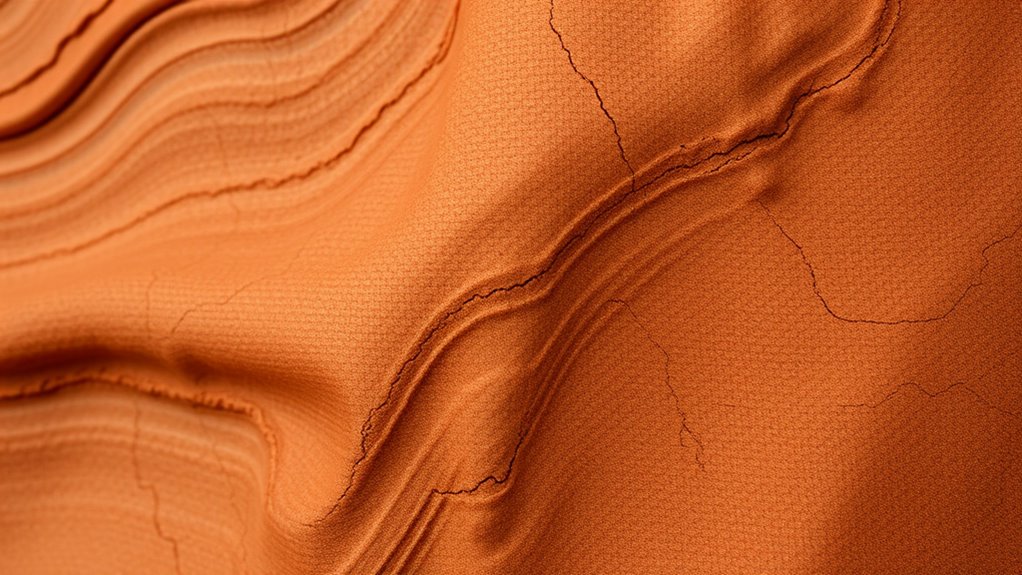
You’ll notice that clay and ochre shades are dominating designer collections, reflecting a strong connection to nature-inspired palettes. These earthy tones offer versatile options, allowing you to make bold or subtle fashion statements with ease. As this trend grows, it’s clear that natural hues are becoming essential for creating depth and authenticity in your wardrobe. Additionally, this focus on organic colors mirrors a broader fascination with natural intelligence and authentic storytelling in contemporary design, highlighting how sound healing science influences aesthetic choices by emphasizing harmony and well-being. Incorporating these hues can also serve as a subtle nod to sustainable fashion, underscoring a commitment to environmentally conscious choices in style.
Nature-Inspired Palettes
As designers turn to nature for inspiration, earthy tones like clay and ochre have surged in popularity, adding a grounded depth to collections. These colors evoke the raw beauty of natural landscapes, from desert sands to burnt sunsets. They bring warmth and authenticity, allowing for versatile styling that feels both timeless and contemporary. By incorporating clay and ochre, designers create palettes that resonate with a sense of stability and organic elegance. These hues also serve as a neutral foundation, enhancing bold accents or maintaining subtle sophistication. As nature-inspired palettes gain momentum, you’ll notice these earthy shades becoming staples in pre-fall wardrobes. They offer a tactile, immersive experience, connecting fashion to the natural world while providing a rich, versatile color story. Additionally, embracing self-awareness can deepen your appreciation for such organic color palettes, fostering a more mindful connection to nature-inspired design choices.
Versatile Fashion Statements
Earthy tones like clay and ochre have moved beyond their natural origins to become key players in creating versatile, eye-catching fashion statements. Designers now use these shades to craft looks that are both grounded and dynamic, easily shifting from casual to formal. You can pair a clay-colored blazer with sleek trousers for a sophisticated office ensemble or combine ochre accessories with a simple dress for a bold pop of color. Their warmth complements a variety of skin tones, making them adaptable choices for many wardrobes. These hues add depth and texture without overwhelming, giving you the flexibility to experiment across seasons and styles. As a result, clay and ochre have become essential in building timeless, yet contemporary, fashion statements that resonate effortlessly.
Styling Tips for Incorporating Deep Hue Layers
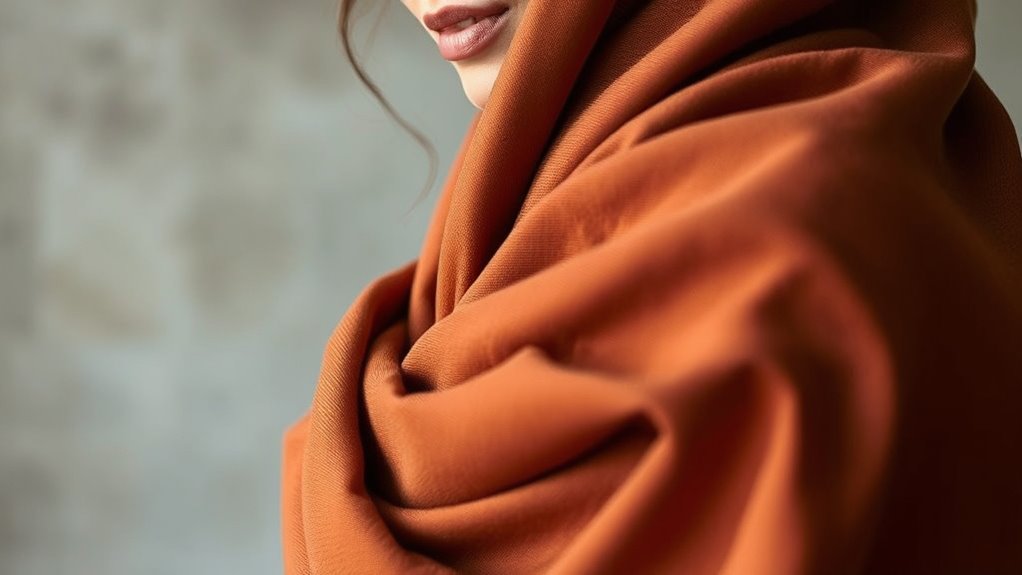
Layering deep hues like clay and ochre can add rich complexity to your wardrobe, making each outfit stand out with warmth and depth. To achieve this, start with a neutral base—think beige, white, or black—and layer your deep colors on top. Mix textures, such as a suede ochre jacket over a cotton shirt, to create visual interest. Play with monochromatic looks by combining different shades of the same hue for a sophisticated effect. Incorporate clean lines and simple silhouettes to let the colors shine without overwhelming. Keep accessories minimal to maintain focus on the layered hues. Remember, balance is key; use deep tones as statement pieces and complement them with lighter shades to prevent your look from feeling heavy.
Accessories That Amplify Warm, Grounded Looks
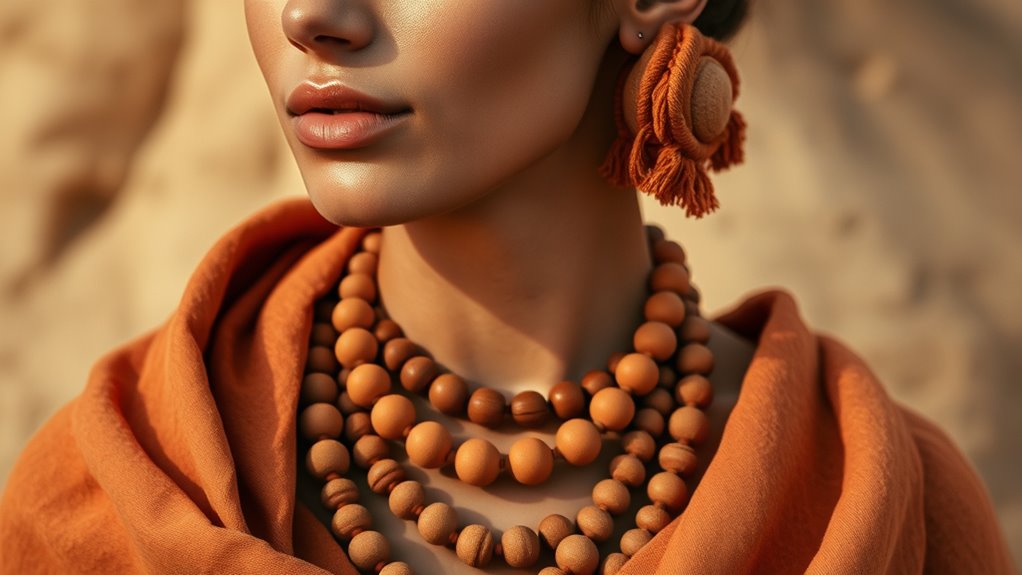
To enhance warm, grounded looks, choose accessories that echo the rich tones of clay and ochre. Opt for jewelry in earthy metals like bronze, copper, or matte gold to add warmth without overpowering your outfit. Consider statement pieces, such as chunky necklaces or bold earrings, that feature natural stones like amber, tiger’s eye, or jasper—these mirror the organic feel of clay and ochre. Scarves and handbags in warm, muted hues can also deepen your look, providing a cohesive, layered effect. Leather accessories, especially in caramel or rust shades, reinforce the earth-inspired palette. Keep accessories textured and substantial to emphasize the grounded aesthetic. With the right choices, your accessories can elevate the warmth and depth of clay and ochre, making your look truly compelling.
Pairing Clay and Ochre With Other Seasonally Appropriate Colors
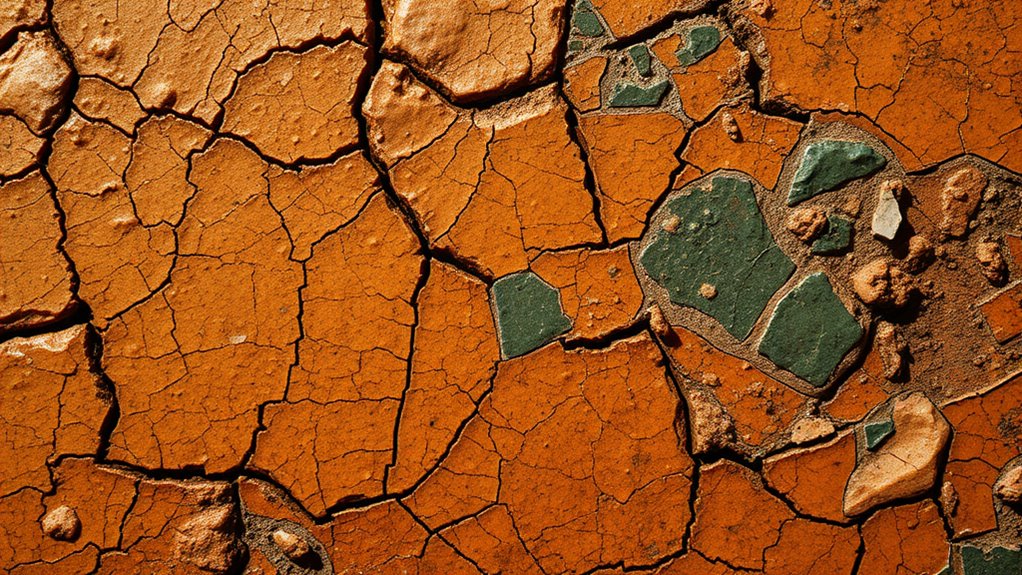
Pairing clay and ochre with other seasonally appropriate colors creates a versatile and striking palette that enhances your overall look. In fall, combine these earthy tones with deep greens, rich browns, and warm burgundies to evoke warmth and depth. For winter, pair them with cool greys, icy blues, or charcoal to add contrast without losing the grounded feel. During transitional seasons, blend ochre with muted mustard or burnt orange to reflect changing foliage, while clay pairs well with soft taupe or beige for a subtle, sophisticated touch. These combinations highlight the natural warmth of clay and ochre, making your outfits feel cohesive and seasonally tuned. Experimenting with textures and complementary hues lets you craft looks that resonate with the season’s mood and your personal style.
Fabrics and Materials That Enhance Color-Drenching Effects
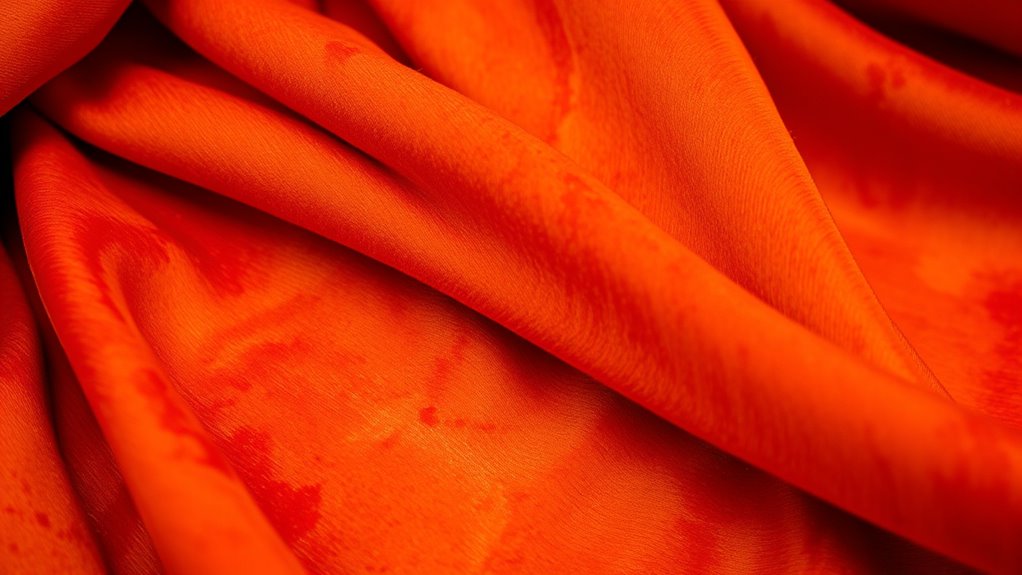
Choosing the right fabrics can make your color-drenching techniques truly stand out. Rich silk and satin add a luminous depth, while textured wool and tweed create a tactile richness that enhances color absorption. Matte cotton and linen offer a muted backdrop that allows deep hues to pop with subtle sophistication.
Rich Silk and Satin
Rich silk and satin fabrics intensify the depth and vibrancy of color-drenching effects, making hues appear more luminous and immersive. Their smooth, reflective surfaces catch light beautifully, enhancing the richness of clay and ochre tones. When you drape these fabrics, the color seems to deepen, emphasizing subtle shifts and undertones. Silk and satin’s natural sheen amplifies the intensity of earthy hues, creating a sense of lushness and vitality. These fabrics also breathe life into muted shades, transforming them into bold statements. Their tactile quality invites closer inspection, drawing attention to the nuanced variations in color. If you want to elevate your pre-fall palette with a sense of luxury and depth, choosing silk or satin will guarantee your color-drenching effects stand out with sophistication and vibrancy.
Textured Wool and Tweed
Textured wool and tweed fabrics naturally enhance color-drenching effects by adding depth and dimension to your look. Their rich surface variations absorb and reflect light differently, making colors appear more vibrant and layered. This complexity amplifies the intensity of clay and ochre hues, creating a more immersive visual experience. When you choose these fabrics, you benefit from their tactile richness, which complements the earthy tones you’re working with. They also provide a sophisticated, timeless appeal that elevates your overall style. To maximize their impact, consider these tips:
- Opt for tightly woven tweeds for sharper color contrast
- Play with mixed textures to deepen visual interest
- Layer with smooth fabrics for contrast
- Choose natural fibers to enhance earthy tones
- Incorporate accessories that echo textured details
Matte Cotton and Linen
Matte cotton and linen fabrics excel at enhancing color-drenching effects through their understated surfaces and natural textures. Their matte finish absorbs light, making the rich hues of clay and ochre appear more intense and immersive. These fabrics’ unrefined textures add depth, creating a subtle contrast that amplifies color saturation. When you apply color-drenching techniques, matte cotton and linen serve as perfect canvases, allowing pigments to settle evenly without shine or reflection. Their breathable, natural fibers also prevent color from pooling or streaking, ensuring a smooth, consistent finish. Use these materials to achieve a raw, earthy aesthetic that emphasizes depth and vibrancy. Whether in garments, accessories, or home decor, matte cotton and linen elevate your color-drenching results with their organic, understated appeal.
Visual Impact: How Color-Drenching Creates Depth and Dimension

Color-drenching in clay and ochre instantly engaging the eye by adding vibrancy and intensity to your look. It creates a rich sense of depth and dimension that draws attention and adds visual interest. By layering these earthy hues, you enhance the perception of form and structure, making your outfit stand out. The boldness of these colors makes shadows and highlights more pronounced, giving your ensemble a dynamic, three-dimensional feel. To maximize this effect, consider how the shades interact with your skin tone and accessories. Incorporating textures and different fabric weights can further amplify the depth created by color-drenching. Overall, this technique transforms flat surfaces into captivating visual stories, elevating your style with a natural, yet striking, depth.
Trends: From Runways to Street Style With Earthy Hues
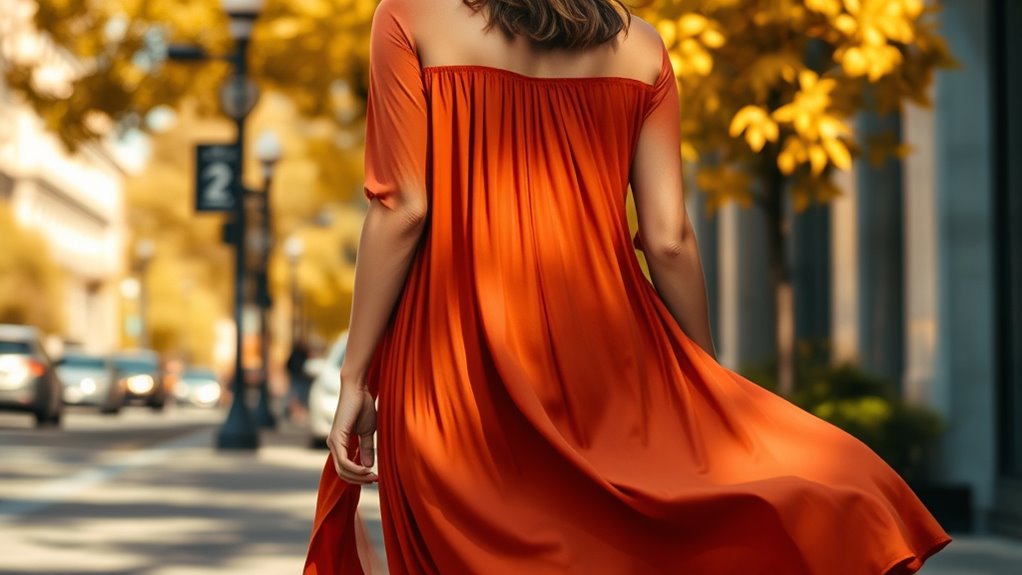
Earthy hues like clay and ochre have moved beyond the studio and into everyday fashion, blending seamlessly from high-fashion runways to street style. You’ll notice these warm tones in layered outfits, accessories, and even footwear, creating natural, grounded looks. Designers embrace earthy colors for their versatility and timeless appeal, making them perfect for pre-fall wardrobes. To help you incorporate these hues, here’s a quick guide:
| Style Element | How to Wear |
|---|---|
| Outerwear | Statement jackets in ochre tones |
| Bottoms | Wide-leg pants in clay shades |
| Tops | Earth-toned knits or blouses |
| Accessories | Leather bags and belts in warm hues |
| Footwear | Neutral-toned boots or sneakers |
This trend effortlessly bridges high fashion and streetwear, allowing you to stay stylish and connected to nature.
Sustainable Fashion and Earth Tones: A Natural Connection

As sustainability becomes a key focus in fashion, earth tones naturally align with eco-conscious values. These hues reflect a commitment to environmental responsibility, emphasizing natural dyes and sustainable materials. Incorporating earth tones helps you reduce reliance on synthetic dyes and lowers your fashion footprint. By choosing fabrics rooted in nature, you support eco-friendly production practices. Earth tones also promote versatility, making your wardrobe adaptable and timeless. Here’s why they matter:
Earth tones support eco-friendly fashion by reducing chemicals and promoting natural, sustainable fabrics.
- They use fewer chemicals in production
- They encourage the use of natural dyes like clay and ochre
- They support sustainable farming and harvesting methods
- They promote durability and longevity in clothing
- They foster a deeper connection to nature and responsible consumption
Embracing earth tones aligns your style with sustainable values, making eco-conscious choices effortless.
Frequently Asked Questions
How Do Lighting Conditions Affect the Appearance of Clay and Ochre Colors?
Lighting conditions markedly influence how clay and ochre colors appear. In bright, natural light, these earthy tones seem more vibrant and true to their actual shades. Under dim or artificial lighting, they can look muted or altered, sometimes emphasizing warm or cool undertones. You’ll notice the colors shift with the environment, so you should view them in different lighting to understand their full depth and character.
Can Color-Drenching Techniques Be Adapted for Plus-Size or Petite Figures?
You can absolutely adapt color-drenching techniques for plus-size or petite figures. Focus on bold, vibrant hues that highlight your best features and create a balanced silhouette. For smaller frames, opt for monochromatic looks to elongate your figure, while larger frames benefit from color blocking to define shape. Play with shades like clay and ochre to add depth and warmth, ensuring your outfit complements your body shape confidently.
What Are the Best Photography Tips for Showcasing Deep Earthy Tones?
Think of showcasing deep earthy tones like capturing the soul of a forest. To do this, use natural light to enhance warmth and depth, avoiding harsh midday sun. Choose backgrounds that complement the hues, like textured fabrics or earthy settings. Play with angles to highlight color richness, and consider close-ups to emphasize texture. Using reflective surfaces can also add a glow, making the tones feel alive and inviting.
How Do Color-Drenching Trends Influence Sustainable and Eco-Friendly Fashion Choices?
You can see how color-drenching trends influence eco-fashion by encouraging more natural, earthy hues like clay and ochre. This shift promotes sustainability because it inspires brands to use eco-friendly dyes and materials that highlight these rich tones. By embracing these deep colors, you support environmentally conscious choices, reduce chemical use, and promote a more sustainable aesthetic that aligns with eco-friendly values.
Are There Specific Cultural or Historical Significances Tied to Clay and Ochre in Fashion?
You might find it fascinating how clay and ochre carry deep cultural roots, whispering stories of ancient traditions and earthy connection. These pigments, historically used in rituals and art, symbolize grounding and heritage. In fashion, they evoke a sense of timelessness and respect for nature’s palette. Wearing these shades subtly celebrates cultural richness, blending history and modern style into a meaningful statement that honors both past and present.
Conclusion
Just like layering earth’s natural shades creates rich, textured landscapes, embracing clay and ochre in your wardrobe adds depth and warmth. Imagine slipping into a deep ochre coat on a chilly morning—suddenly, your outfit feels rooted in nature’s tranquility. These earthy hues aren’t just trendy; they ground your style in sustainability and timeless appeal. So, experiment with color-drenching, and let your wardrobe bloom with the beauty of the earth’s own palette.
